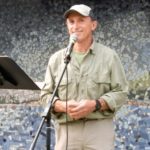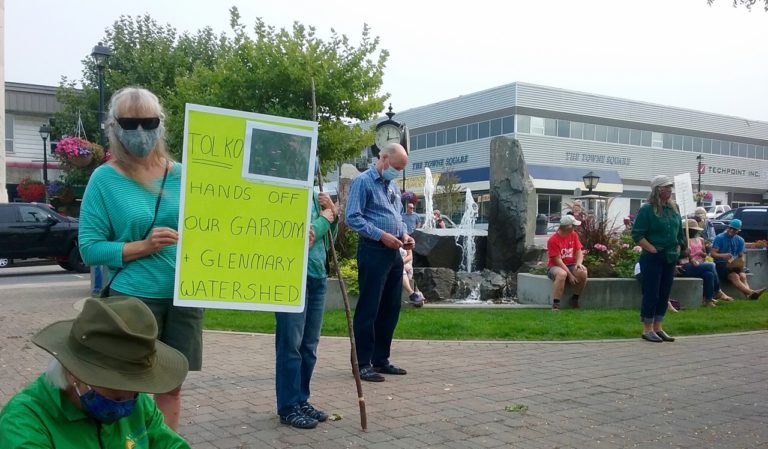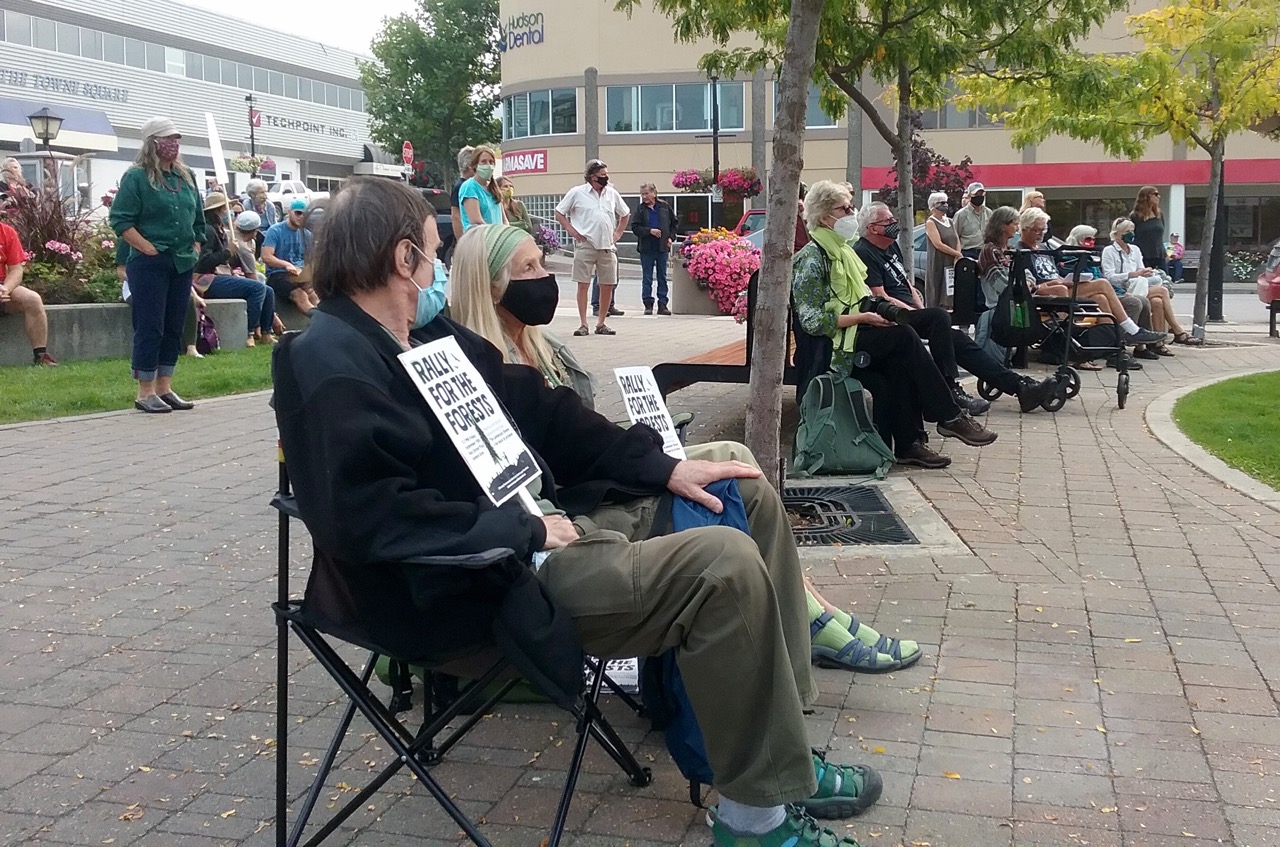
On September 18th, the Shuswap Environmental Action Society held a rally in conjunction with Forest March protests held throughout the province. There were three speeches and a short play written and directed by James Bowlby, entitled “The Lumberjack’s Dilemma” and performed by the Salmon Arm Actor’s Studio.
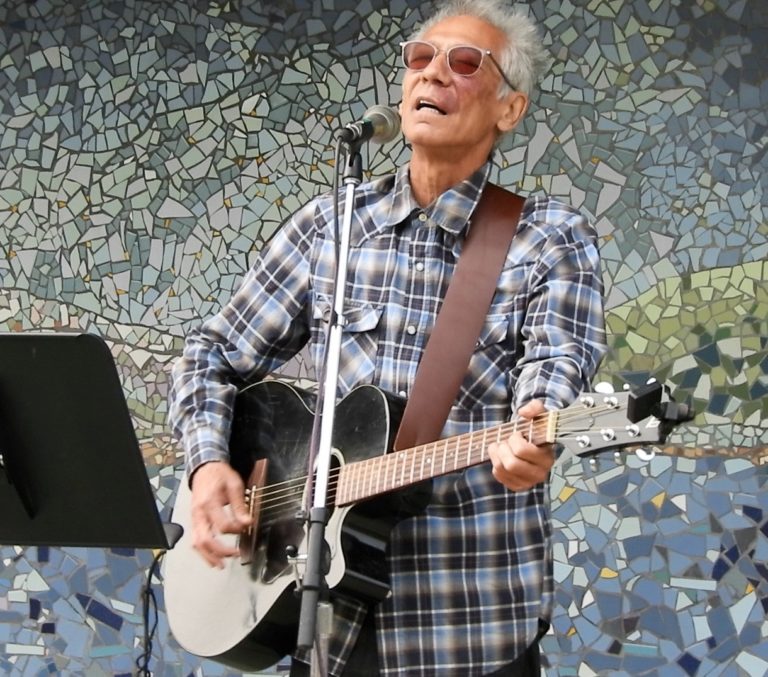
[here is the coverage of the rally from the Salmon Arm Observer: rally news ]
Here are the speeches:
Making our voices heard for forest protection
by Jim Cooperman
Preamble: First and foremost, I want to acknowledge that we are fortunate to be gathering together today on the unceded traditional territory of the Secwepemc people who have lived here peacefully since time immemorial.
To begin with, I want to thank all of you for braving the smoke and the pandemic to be here today in support of the renewed campaign for forest protection. As well, I want to thank Dr. Art Borkent for presenting his perspective, Linz Kenyon for sharing his apropos music, Acorn Music for supplying the sound system and James Bowlby and the Salmon Arm Actors Studio for creating the play and presenting it today. (Neskonlith elder and Councillor Louie Thomas also came and gave a much-welcomed talk)
Why are we here and why today? The BC forest campaign has a new leader, Jennifer Houghton. She, along with Taryn Skalbania, who is from Peachland where clearcutting has devastated the water supply, are the two key people responsible for organizing this day of protest. Jennifer is also a Grand Forks flood survivor and not just one flood, but three of them. While the government and the forest industry blame the weather for those disasters, in reality it was massive clearcutting in the watersheds of two rivers that is the real reason for the flooding. When the trees are removed, more snow piles up in the winter and melts much faster in the spring.
Jennifer is one busy activist, as in addition to organizing this day of protest that is happening in 16 communities around the province, she also set up a 5-day virtual summit, with talks by environmental experts about forest mismanagement, the values of old growth, and the changes needed to better protect forest ecosystems. She has distilled all the changes needed down to four demands in what is called the New Forest Charter: 1. Put nature’s needs first, not corporate profits; 2. Eliminate corporate control of the forests; 3. Create regional forest councils for decision making; and 4. Ensure forest management is based on science, not corporate practice. As well, she along with two others have launched a class action lawsuit against the government and the companies for causing the flooding in Grand Forks.
Jennifer’s leadership and persistence has inspired the Shuswap Environmental Action Society to bring you this event today. We have been fighting this battle now since 1989 and thanks to the then change of government in Victoria, we were able to accomplish much during the 1990s, including the protection of over 25,000 hectares of new parks, improved management that was enshrined in a land use plan developed after 5 years of negotiation and the creation of many hundreds of old growth management areas, including one of the largest in the Larch Hills.
When the government changed again nearly 20 years ago, forest management along with public involvement quickly went downhill. Forest management was handed over to the corporations under the guise of “professional reliance,” land use planning tables was eliminated, log exports soared, many jobs were lost as mills closed, and the rate of logging continued unabated at unsustainable levels. As a result, B.C.’s forests went from a carbon sink to a carbon source and in some years now produce more carbon than the tar sands. Most of the forestland is now controlled by five, well-subsidized corporations who have used their profits to purchase sawmills in the U.S. and Sweden, where they now employ more workers than they do in this province.
Many of us rejoiced when the new government was installed in Victoria, as we hoped it would bring major changes and improved environmental protection. Our hopes have been dashed. Along with promoting and subsidizing climate destroying LNG and continuing on with the farmland destroying and money wasting Site C dam debacle, the new government has made NO changes to forest management. Instead they have carried on with business-as-usual forest destruction and corporate giveaways.
Do you think that the recent old growth forest announcement is helpful? Think again. Here is how longtime famed environmentalist Vicky Husband described the news; “The government’s response to the Gorley-Merkel old growth report is a shoddy piece of spin-doctoring in advance of an election. It is duplicitous in intent; short on facts; and intentionally misleading for the electorate giving the appearance of doing something when the reality is to keep the industry logging the little remaining productive old growth.”
Out of the supposed 342,739 hectares of forest deferred, only 32,000 hectares is actually old growth and the rest has already been logged or is second growth. As well, the government avoided making any decisions regarding the 14 recommendations from the old growth report.
In June, a study by three forest ecosystem specialists made headlines due to its alarming findings that the amount of British Columbia’s old growth forest has been grossly overestimated. The common government and industry narrative that there still remain millions of hectares of ancient trees has been deemed misleading, because most of these forests contain only puny trees. These scientists determined that out of the province’s 13.2 million hectares of remaining old growth forest, only three percent contain large trees, which totals just approximately 400,000 hectares.
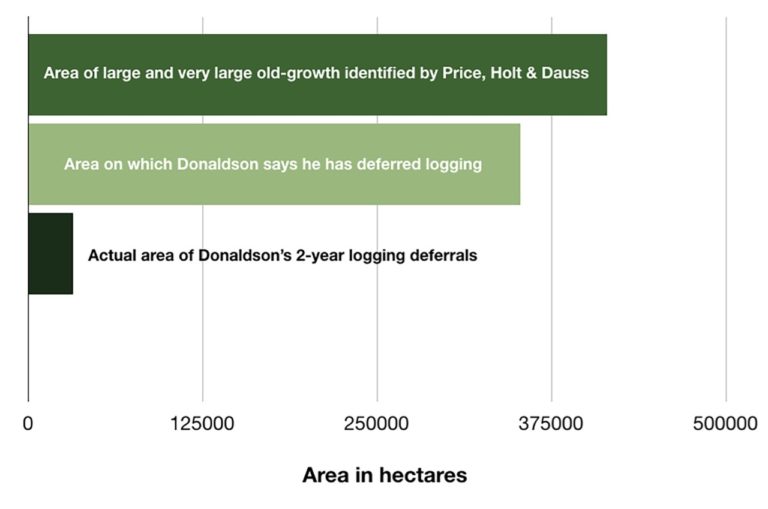
So far, most of what I have covered refers to the province as a whole. What is the forest situation like here in the Shuswap? As for the old growth, we are dependent on the local companies to adhere to the land use plan that mapped out hundreds of old growth management areas called OGMAs that are to be protected. However, the companies pulled a fast one. These OGMAs were never enshrined in legislation and thus companies can move them. This has already occurred in the Shuswap River drainage.
Our major concern in the Shuswap is the threat of more landslides, as already we have experienced too many damaging slides caused in part by clearcutting and roadbuilding. The latest debris torrents in Sunnybrae prompted the CSRD to have a study made and as a result they have called for a moratorium on logging in the Bastion hills above the lake. But of course the provincial government is ignoring their concerns and BC Timber Sales is now forging ahead with their plans to log above Bastion Creek, which poses extreme risk to the homeowners at the Totem Pole Resort.
We have a huge challenge ahead of us as the concerned public to move this agenda forward. In the face of all that is wrong with what the government is doing and not doing regarding forest management, we cannot continue to remain idle. Despite so many emergencies facing humanity, from the pandemic to climate change to political unrest, we must continue to give a voice to forest protection, as life in this province is synonymous with the health of our trees and our watersheds. Today, we are helping to raise awareness about the need for change, as there is not that many years left until business-as-usual in the forests will contribute to environmental collapse. All of you can now take this message forward and help spread the word. Thank you again for your participation and support.

Talk at Forest March BC at Ross St. Plaza, Sept. 18, 2020
by Dr. Art Borkent
I’m an entomologist, so I study insects. And I’m an insect taxonomist, so I describe species. I study biodiversity first hand and I’ve done so for my entire life, studying the species that are out there and their classification.
I want to address the problem of clear-cut logging and the subsequent planting of trees.
Because of the times we live in, where true facts are called fake facts and Google the source of truth for many, can give you any answer you might be looking for, I want to point out something. The information I’m sharing with you is backed up by literally hundreds of thousands of studies and many thousands of scientists, who have spent their lives studying biodiversity. All the ones I have had the privilege of knowing also truly love the species they work on and are profoundly distressed by what is happening on our planet home.
There are many reasons why forest practices in BC and many other places on the planet are unacceptable scientifically and I want to give you just two.
Here are some facts:
1. The first has to do with biodiversity. Generally in BC, biodiversity is described by forestry as a handful of tree species and a few mammals such as bear, deer, moose and caribou and within freshwater as salmon. The reality is something completely different. In BC with have over 20,000 species of named insects and at least another 10,000 without names. Of this huge diversity of 30,000 species we know virtually nothing about them, their life cycles or where they live exactly, entirely because no one is looking. Of these 30,000 species about 150 or so are considered forest pests because they attack living or recently dead trees.
So what are those other species doing? I want to explain how some insect communities work and particularly within forest. So bear with me.
A popular study by undergraduates in biology is to study what happens to a cow pie after it is dropped on the ground. When it is fresh and hot there are species of yellowish flies, about a cm long, which immediately land on the poop. They are called scatophagids, which is Greek for eaters of poop. But shortly after, these flies are joined by other insects, and, depending on where you live, there are about 70 or so species of insects that work over the decaying manure till it disappears into the soil after 3-4 months. The same phenomenon happens with trees. When a tree is vulnerable or has died, there are insects which attack it. These are the ones called forest pests. But they are just the first of a 50-100 species of insects that ultimately break the wood down, with the help of bacteria and fungi, into soil. There are different insects on different species of trees and there are different species on logs from those on branches and leaves. And this happens to shrubs and other plants too. So you can see with many plant species, you rapidly get many species of insects that form the backbone of biodiversity in our forests. That biodiversity is vital to healthy and sustainable forests. And we know that insects are the movers and shakers of ecosystems everywhere.
When forest pests are controlled by pesticides, when areas are clear cut and replanted, this whole complex succession of species is completely interrupted. These clear cuts are actually ecological deserts.
2. Here’s the second point. When clear-cuts are replanted with nursery plants, it stops a healthier next generation. Forestry is fond of using inflammatory language such as apocalyptic, total devastation, and forest crisis. However, when we see outbreaks of such native species as mountain pine beetle in these past years and the Western Hemlock looper flying about now, we are seeing a forest system in action, as it has done for millions of years. In spite of so much rhetoric, the reality is that there are nearly always trees left behind by these outbreaks, and this also includes fires. There are survivors that should form the next generation. This is exactly how evolution works, the strong survive. Most people know about how lodgepole pine cones need fire to open up and release their seeds. This is the result of many thousands of years of selection where early ancestors were hit by fire, a few survived and then were hit again with fire, with this happening over and over again till the present day, where these trees NEED fire to thrive. This is true of us as humans too. Everyone standing here are survivors of previous pandemics that killed many of our ancestors. We are the source for the next, stronger generation. As such, planting trees from nursery stock by forestry does an end run around this process, a process that would otherwise help species to adapt to changing conditions.
I’m going to leave you with that. The take-home message here is twofold that can be used as powerful arguments against forest practices: first our old growth forests are full of thousands of species that form a hugely complex web of life and secondly, replanting interrupts the evolution are newly adapted forms of a species that can better handle further disturbance. In large measure, we should leave much of the forest alone and when we harvest, we should try to mimic nature processes that we know forests can handle. These are NOT clear cuts, and NOT plantations of trees from seed stock. The result of those processes has nothing to do with real forests – it really is just another form of gardening where carrots are replaced by a tree species.
I’d like to leave you with one quick thought. During this Covid crisis we’ve seen quite a difference response from the various governments. In Ontario and Quebec there was a lot of rhetoric from the politicians. Here in British Columbia, we have a premier who said “Actually I don’t know a thing about this”, so here’s the Minister of Health, who said basically said, “I don’t know anything either” but I’ve got some scientists here who do. These people have studied this carefully and Bonnie Henry, who stands in front of a whole group of scientists who are going “Yup, we are in accord, this is a good way of handling the pandemic”. Of course, you can see the difference for our brothers and sisters south of the border, what a disaster that is. How interesting it would be if we had leadership that said “We have an issue with biodiversity in our forests, issues about forestry. Let’s listen to scientists who have studied not forestry per se, but biodiversity because they know so much about it. And it would be so interesting if the same approach was taken toward our homeless people, toward poverty, we would have, I think, more reasonable solutions to the problems that face us. And certainly that’s the case with biodiversity.
So I hope you can use those tools when you’re talking to friends to say “Hey, there’s a whole lot out there that we don’t know and we need to take care of it. In large measure forestry practices should mimic natural events that the forest knows and has live with for millions of years.
That’s my scientific opinion, and as I said, representing many thousands of other scientists. I hope this was useful.
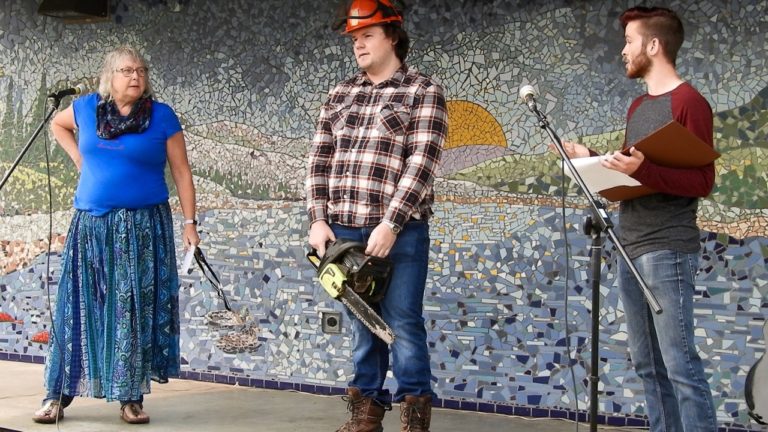
An excerpt from “The Lumberjack’s Dilemma:”
(Lumberjack enters SINGING with chain saw.)
L.J.: I’m a Lumberjack and I’m OK,
I sleep all night and I work all day
I cut down trees —-
#2 :Just a minute.
L.J. What?
#3: You say1 you’re OK? I don’t think so.
L.J. You just interrupted my song.
#2 I know. I did it on purpose.
L.J. You did it on purpose? It’s a lovely rousing song. (sings again) “I’m a Lumberjack and I’m okay”
#3 Hey! You guys go around cutting down trees with no thought of what that means.
L.J. It means jobs. ℗ Are you saying I don’t think?
#2 I think you don’t think of the consequences.
L.J. That’s a pretty big word to be throwing around.
#3: But what happens when you go in and clearcut huge blocks of forest?
L.J. Well, we leave whole areas for new trees to grow.
#2: So you do tree planting?
L.J.: Well, yeah.
#3: Well thanks to Prime Minister Trudeaus’ plan to plant 2 billion trees 250 million seedlings have been planted this year with 50 million on track. 300 million is BC’s share.
#2 So glad there’s some good news.
L.J. But there’s only so many seedlings available –
#3: The department oF Land and Forests need more seedlings..
#2 Unfortunately there’s more bad news. What taxpayers all across BC, you people listening, need to be aware of – is that Industrial logging is destroying our old growth forests, which means wildlife habitat, and water. are affected. Legislation gives private corporations authority over public land. Communities have no power.
#3 How does even this work?
#2 Well according to Registered Professional Forester and forest ecologist with 40 years in research, Herb Hammond of Silva Forest Foundations, says, “we have public forests in name only; they are really private timber supplies.” The big companies have consolidated so there are only 5 of them that control 60 % of the allowable cut.
- J. What?
#3: Yes. Public forests were essentially given to private enterprises by the Christie Clarke government to the big milling companies, on the promise they would create employment and vibrant communities by logging and milling public trees. The companies promised to ensure that vital essential benefits, like pure air and water, biological diversity, climate moderation, and carbon capture and storage provided by forests would be protected. But their real interest is to make money.
#2: What did she expect?
L.J.: Dont dump all this on me. I just cut down trees.
#3 Yeah, but remember consequences? As a result of you and so many other forest workers, we have spring floods and fall droughts, hundreds of species of plants and animals have been threatened. 2.
L.J. That’s a bit strong!
#3 Yeah, but true! British Columbia has a whopping 1,807 species of animals and plants at risk of extinction, Like the woodland caribou.
LJ: I like animals.
#3. We have more endangered species than any other province or territory in Canada.
#2. And yet B.C. is still one of the only provinces in Canada without legislation dedicated to protecting and recovering species at risk.
L.J. I can take it; just make me the bad guy.
#3 Well if you weren’t just a logger, but a company owner, you wouldn’t just be bad, you’d be rich.
- J. Me?
#2 Yes, you. Over the past 10 years, British Columbians have subsidized timber company profits at the rate of 365 dollars million per year. On top of all of this corporate riches, timber companies sell tenure rights to public forests to generate private profits while ecosystem benefits from these gifts of public land to timber companies are all but ignoreD.
#3: How much of our taxes?
#2: $365 million a year! And some of the companies have used money to buy mills in the US and Sweden.
LJ: You are a tree hugger. Both of you.
#2: Well, with the way you are going, being blind to consequences, there probably won’t be any trees to hug.
LJ: There will always – You’re just making up these a ℗ number things things
#3. Statistics.
L.J. See, you admit it
#3 We don’t deal in manufacturing stories.
